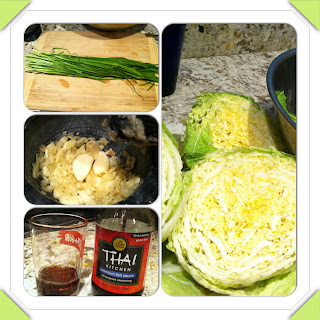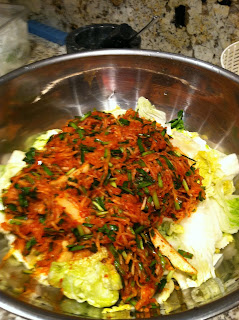Growing up we always had kimchi in the fridge. I enjoyed eating it right away when it “ripened”. It was crisp, crunchy and spicy! As it soured, my mom would make delicious kimchee gigae with rice dumplings. A nice warming soup on cold days. One of my favorite snacks is kimchi pancakes. So easy, but a nice savory treat.
Kimchi is a super healthy dish. It is full of vitamin C, anti-oxidants, fiber, minerals, and pro-biotics. Whenever I felt sick or had a cold, my mother gave me kimchi soup. It helps to boost your immune system to help keep you healthy.
I remember learning how to make kimchi in kindergarten at school and at home. You had to learn since it was eaten at every meal and a staple Korean food. This is a “quick” kimchi version that my mom made with a few of my additions. I do use a mortar and pestle to make a garlic paste. Oma was right when she said the garlic was sweeter this way.
Many of the recipes from Oma has no measurements since she seasoned her food with the guide of her taste buds. A handful of this, a pinch of that spice was her technique. She would always say”Taste your food as you prepare it”. So the measurements I have in the recipes are guides. I adjust to my own taste buds and so should you.
 |
 |
Add about 3 Tbs of water to the top and mix water over the top of the cabbage. Cover bowl with a towel and let it sit on the kitchen counter for about 4 hours. Cabbage will wilt down and reduce. Take one piece, rinse underwater, and taste. If it is a little salty, then it is ready.
 |
| Cabbage being rinsed. |
 |
| Cabbage after rinsing and excess water squeezed out. |
Now make the red pepper paste. Peel your diakon radish and shred it. If you can’t find diakon radish, use turnips.
 |
| shredded diakon radish |
 |
| peeled diakon radish |
Take a bulb of garlic or 10 cloves and use mortar and pestle to make a paste. This process mixes the garlic oil and makes it not as bitey. If you don’t have one, then you can use a garlic press. Put this into the bowl with the shredded diakon radish.
Grate with a ginger greater or zester about 2 inches of ginger. I leave the skin on. Place in bowl with radish and garlic.
 |
| Crushed Red Peppers 1/2 cup |
| 1 bunch of Korean Chives |
 |
| Fish sauce 2 oz. |
Chop up chives and 1 small onion. Add these along with 1/2 cup of crushed red peppers, and 2 oz of fish sauce to diakon bowl. Mix all the ingredients in the diakon bowl together. Add about 2 tsp of sugar. Mix again. Take the red pepper paste and place on top of the cabbage.
 |
| Cabbage with diakon, red pepper paste on top. |
Put on clean gloves and mix the paste with the cabbage very thoroughly. Taste a cabbage and if it isn’t spicy enough for you add a little more chili peppers. My mother said you know you’ve added enough red peppers if your hand started burning. My kimchi is made milder than my mother’s kimchi. Also, if it seems too salty, add a tsp of sugar. Be careful to not add too much sugar.
 |
| 2 extra Tbs of chili pepper added. |
Mix again…..
This kimchi is ready to be packed into a jar.
This batch filled 2 quart size jars. Pack the kimchi in quart jars to avoid air pockets. Place lid on but do not screw it on tightly. Place jars on top of a dish or tray. Keep in room temperature for 72 hours. During lacto-fermentation process, you will see bubbles and some juice leaking out. After 72 hours, it is ready to eat! Keep refrigerated and it will keep for a few months if it lasts that longs. Once it starts to sour, use it in soups. I will post some kimchi recipes soon.
This is a picture of my uncle’s kimchi clay pot buried in the ground. This is the traditional way to ferment Kimchi. I took this picture on our family visit to Korea a few years ago. It was really exciting to see traditional foods made in traditional ways.
| Kimchi fermentation traditional way. Clay jars buried in the ground keeps temperature constant for fermentation. |
Oma’s Quick Kimchi~ 김치
Supplies: mortar and pestle, ginger grater, 2 large bowls, 1 colander, 2 quart jars with lids ( maybe a pint jar too), sharp knife, cutting board, plates, clean kitchen gloves.
- 1 large Napa Cabbage ( substitute with bok choy too)
- about 3/4 cup of Sea Salt ( you may not use all of it)
Cut the Napa Cabbage into 2 inch pieces. Place about 1/4 of it in a bowl and sprinkle about 3 Tbs of sea salt over the cabbage. Repeat this process with sprinkling sea salt over cabbage until all the cabbage is in the bowl.
Add about 3 Tbs of water to the top and mix water over the top of the cabbage. Cover bowl with a towel and let it sit on the kitchen counter for about 4 hours. Cabbage will wilt down and reduce. Take one piece, rinse underwater, and taste. If it is a little salty, then it is ready.
Set aside another bowl on kitchen counter. Place colander in sink. Place about 1/3 of the cabbage in colander then rinse with cold water thoroughly. Grab a handful of rinsed cabbage and squeeze water out, then place in new bowl. Repeat this process until all the cabbage has been rinsed, water squeezed and in new bowl.
Red Chili Pepper Diakon Paste:
- 1 medium Korean Diakon radish ( or long Japanese or 2 large turnips) shredded
- 2 inch piece of ginger grated
- 1 bunch of Korean scallions ( or green onions) chopped
- 1 medium finely shredded onions
- 1 bulb or 10 cloves of garlic, crushed with mortar and pestle ( or garlic press. Never use pre-made garlic paste)
- 1/2 cup Red Chili Peppers
- 2 tsp sugar
- 2 oz Fish Sauce (I use Thai Kitchen )
Mix all the ingredients for paste. Take the red pepper paste and place on top of the cabbage.
Put on clean gloves and mix the paste with the cabbage very thoroughly. Taste a cabbage and if it isn’t spicy enough for you add a little more chili peppers. My mother said you know you’ve added enough red peppers if your hand started burning. My kimchi is made milder than my mother’s kimchi. Also, if it seems too salty, add a tsp of sugar. Be careful to not add too much sugar.
Pack the kimchi in quart jar to avoid air pockets. Place lid on but do not screw it on tightly. Place jars on top of a dish or tray. Keep in room temperature for 72 hours. During lacto-fermentation process, you will see bubbles and some juice leaking out. After 72 hours, it is ready to eat! Keep refrigerated and it will keep for a few months if it lasts that longs.




